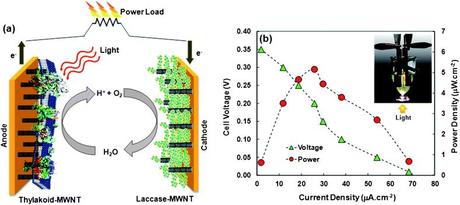
Photo: (a) Photo-electrochemical cell schematic.
(b) Steady state and power density curves
to produce energy.
For a specified number of light photons received by plants, the same number relates to electrons produced -- energy. This is an efficiency of 100% compared to current solar panels at 12% to 17% efficiency levels. Research is catching up as a publication in the journal Energy and Environmental Science by researchers at UGA College of Engineering at the University of Georgia explains.
Their concept -- while ingenious is simple -- they exploited the theory of photosyntheses. As we know, during the process of photosynthesis plants use sunlight to split water molecules into hydrogen and oxygen atoms releasing free electrons that undergo a series of chemical reactions to produce sugars used for plant growth. This team figured out a way to capture these electrons during this photoelectrochemical process before the electrons are taken up by other chemical reactions. They did this by modifying specific proteins found in structures in plant cells called thylakoids. These thylakoids are responsible for capturing and storing the energy received from the sun.
"In the near term, this technology might best be used for remote sensors or other portable electronic equipment that requires less power to run,"..."If we are able to leverage technologies like genetic engineering to enhance stability of the plant photosynthetic machineries, I'm very hopeful that this technology will be competitive to traditional solar panels in the future." said Ramaraja Ramasamy, corresponding author of the paper (ref).
Source Journal: Energy & Environmental Science.
